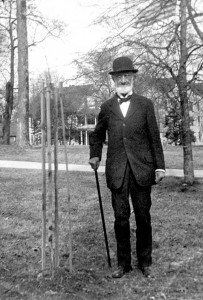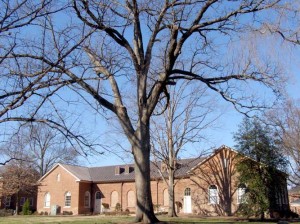UNC’s Noble Grove

Former UNC President Kemp Plummer Battle (1876-1891) beside newly planted Davie Poplar Jr. in March 1918. Davie Jr. now stands tall and proud between Davie Poplar and Davie Poplar III. Photo from North Carolina Collection Photographic Archives.
By Ken Moore
Most folks are familiar with the 200-plus-year-old tulip poplar Liriodendron tuliperifera, affectionately known as the “Davie Poplar.†It lives in the center of UNC’s McCorkle Place, the campus quad between Franklin Street and South Building. It was beneath that singular tree that legend credits the founding fathers’ selection of the site for the state’s university.
Davie Poplar contemporaries still standing include a mighty double-trunked male American holly, Ilex opaca, a former state champion post oak, Quercus stellata, and a statuesque persimmon, Diospyros virginiana.
To honor these noble trees and hundreds of planted specimens on the UNC campus, the university has published an 80-page guide, The University of North Carolina at Chapel Hill’s NOBLE GROVE: A walking Tour of Campus Trees. It’s available at Student Stores and the N.C. Botanical Garden’s gift shop.
The guide describes four walks encompassing the four main quads of the campus. The descriptions of 100 specimen trees include original forest giants, newly planted native and exotic species and cultivars, with line illustrations by Bonnie Dirr. The text by Michael Dirr, nationally known horticulturist and professor emeritus of horticulture at the University of Georgia, provides specific references to cultivars suggested for landscape use and facts about size and location of national-champion relatives of significant campus specimens.
Mike Dirr will be on campus April 22 for a “walk and talk†celebrating UNC’s trees. The walk, beginning at the front steps of Wilson Library at 3:30 p.m.., is free; no registration required. A reception and viewing of the special exhibit, “Noble Trees, Traveled Paths: The Carolina Landscape Since 1793,†follows in Wilson at 5:00 p.m. Mike’s talk, this year’s Gladys Hall Coates University History Lecture, follows at 5:45 p.m.
The engaging exhibit of text, illustrations and photos, describing the evolution of the campus landscape and the many people who played significant roles in that evolution, continues through May 31, 9 a.m. to 5 p.m. weekdays, 9 a.m. to 1 p.m. Saturdays and 1 to 5 p.m. Sundays in Wilson’s North Carolina Collection Gallery.
One text panel from the exhibit:
“To Have a Good Influence upon the Manners of Young Menâ€
Letter (facsimile) from Elisha Mitchell to Trustee Charles Manly,
December 27, 1849.
In the letter below, Mitchell, in his role as University bursar or business officer, notifies Manly of improvements made to the grounds in the years from 1847 to 1849. Of particular interest is the expectation that well-manicured grounds will improve the manners of the students:
“The improvements extending over a large space do not make a great show at any particular spot, yet a good deal has been accomplished and the heaviest part of the work done. The giving of some grace and beauty to the approaches

This former state champion 200-year-old post oak still stands proud near Person Hall on the UNC campus. Photo by Ken Moore.
to the buildings and to the walks around them is supposed to have a good influence upon the manners of the young men and to impress strangers favorably.â€
Don’t miss this opportunity to take a “closer look†at our people/plant heritage.


Comments are closed.